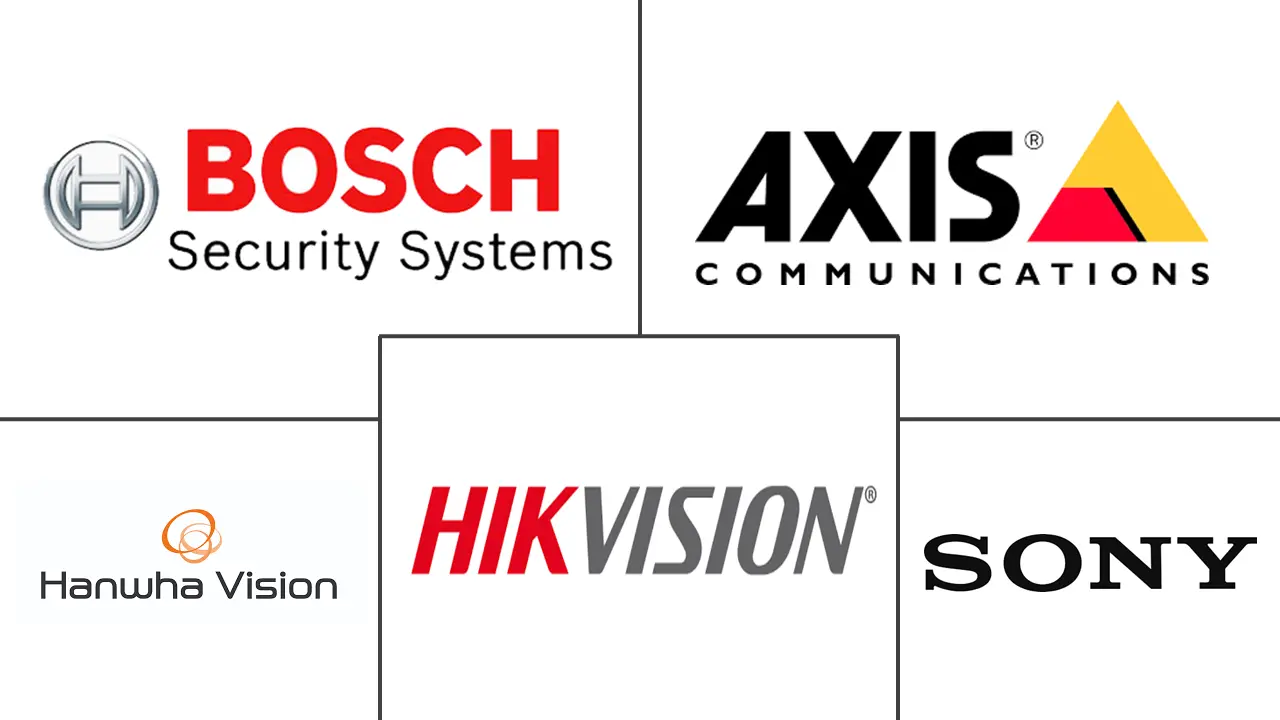Europe Surveillance IP Camera Market Size and Share
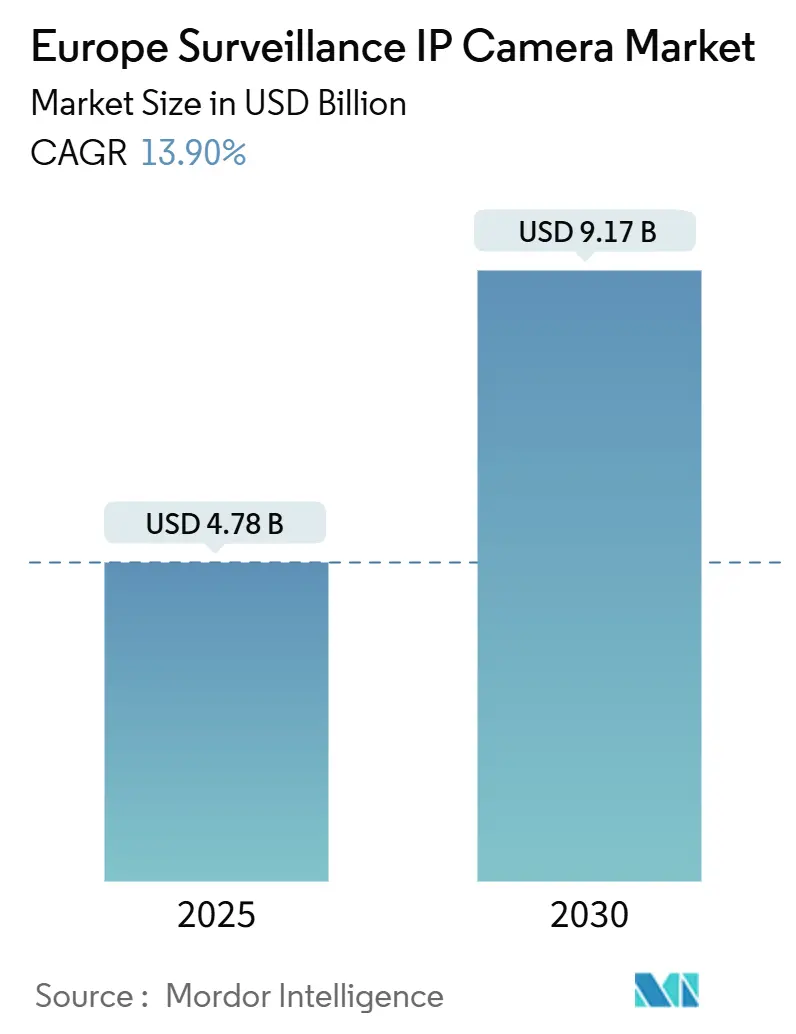
Europe Surveillance IP Camera Market Analysis by Mordor Intelligence
The Europe Surveillance IP Camera Market size is estimated at USD 4.78 billion in 2025, and is expected to reach USD 9.17 billion by 2030, at a CAGR of 13.90% during the forecast period (2025-2030).
- Heightened concerns surrounding terrorism, burglary, and other criminal activities underscore the demand for robust surveillance solutions. According to Numbeo, in 2024, France has a 55.3 crime index rate, considered the highest among all the countries. Both governmental bodies and private enterprises are increasingly turning to IP camera systems to bolster safety in urban settings, safeguard critical infrastructure, and protect high-risk areas. This shift is part of a broader movement towards proactive security measures, with IP cameras at the forefront of threat detection, incident response, and investigative efforts.
- Technological strides in camera sensors, marked by higher resolutions, improved low-light performance, and broader dynamic ranges, have significantly bolstered the quality and functionality of IP cameras. Moreover, advancements in video analytics – encompassing object detection, facial recognition, and behavior analysis – have imbued IP cameras with heightened intelligence, making them more effective for security and monitoring tasks. Pairing IP cameras with cloud computing, mobile applications, and Big Data analytics has further empowered functionalities, enabling remote monitoring, centralized management, and sophisticated data-driven insights.
- Further, retail, logistics, manufacturing, and hospitality businesses are increasingly leveraging IP cameras. These cameras serve multiple purposes, from inventory management and employee monitoring to enhancing customer experiences. IP cameras are poised to introduce even more advanced features, such as face detection and recognition. Retailers, for instance, are set to harness intelligent video analytics (IVA) capabilities, including people counting and heatmaps, to scrutinize footfall patterns and bolster their bottom line. Meanwhile, public spaces and transport centers are turning to IVAs, particularly for features like Missing/Suspicious Object Detection, to bolster security. On the other hand, manufacturing facilities and warehouses increasingly adopt IVAs, such as On-Duty Detection and Safety Helmet Detection, to prioritize employee safety.
- Stringent data protection regulations, exemplified by the EU's GDPR, have heightened concerns regarding the ethical use of surveillance cameras and the safeguarding of personal data. Adhering to these regulations necessitates that both IP camera manufacturers and end-users adopt stringent data security protocols, thereby potentially escalating deployment complexities and costs.
- Although the costs of IP cameras have trended downwards, the initial outlay for a comprehensive surveillance setup, encompassing cameras, networking infrastructure, and storage, can still pose a financial hurdle for many. Additionally, ongoing expenses related to maintenance, software updates, and technical assistance further compound the total cost of ownership, often rendering the investment a tough sell for organizations.
- Macroeconomic factors such as Russia-Ukraine war impacted as the supply chains have directly impacted the availability and distribution of electronic components, notably those crucial for IP camera manufacturing. Consequently, these disruptions have triggered shortages, shipment delays, and price hikes for IP cameras and associated gear. The impact is particularly pronounced in European nations heavily dependent on imports.
Europe Surveillance IP Camera Market Trends and Insights
Transportation and Logistics End-User Industry is Expected to Hold Significant Market Share
- The transportation and logistics sector, encompassing pivotal infrastructure like airports, seaports, railways, and logistics hubs, stands as a prime target for security threats ranging from terrorism and vandalism to cargo theft. By implementing advanced IP camera systems, companies in this sector can bolster their security measures, keep a vigilant eye on high-risk zones, and promptly address any incidents that arise.
- Moreover, the EU shifted from a modest trade deficit during the Great Recession and Eurozone crises to a significant surplus after 2011. This surplus, primarily led by nations such as Germany, was driven by their proficiency in exporting chemicals, heavy machinery, and other manufactured goods, all the while staying cost-competitive. Eurostat data reveals that the EU's annual share of global exports rose from 13.7% in 2022 to 15.8% in 2024, signaling a promising trajectory for the global market and, consequently, for the market under study.
- Integrating IP camera systems with video analytics empowers transportation and logistics firms to monitor vehicle movements and asset utilization and pinpoint operational bottlenecks and inefficiencies. This data-centric strategy aids in streamlining processes, optimizing resource allocation, and ultimately boosting productivity.
- In Europe, transportation and logistics firms frequently team up for joint infrastructure ventures, like logistics hubs or multimodal transportation centers. These projects necessitate advanced IP camera systems. By working together, these collaborations capitalize on economies of scale and drive the industry towards standardized surveillance technologies.
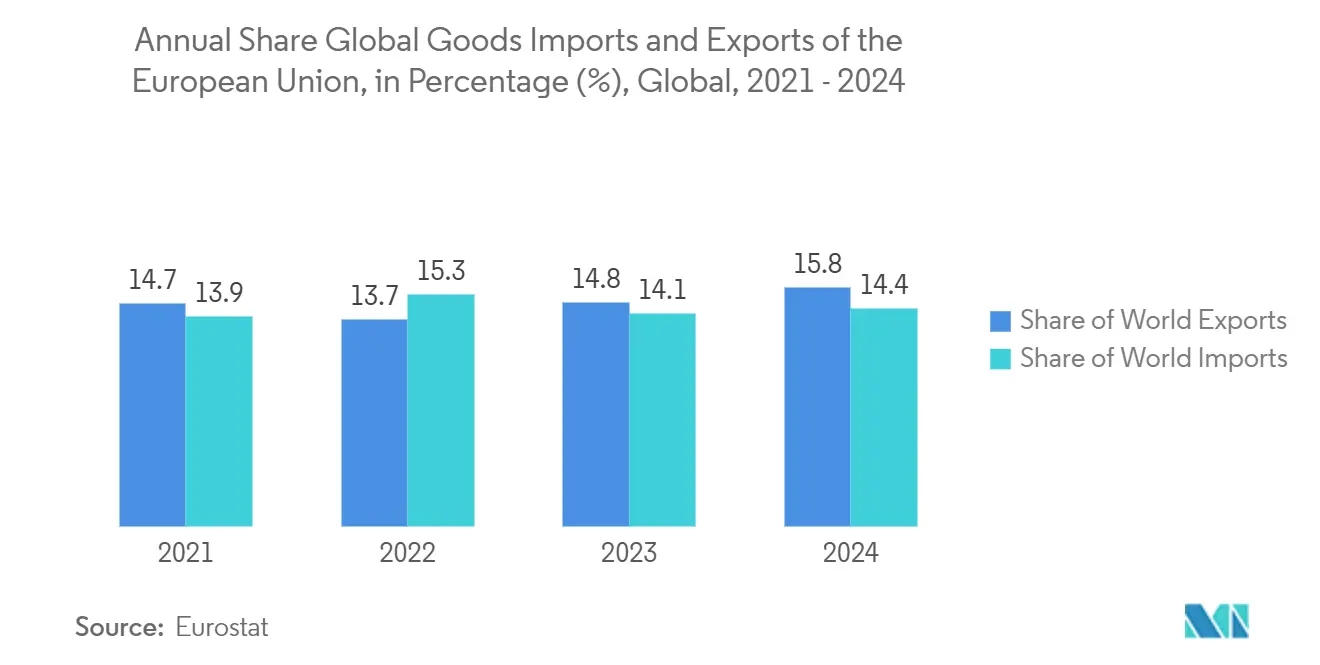
United Kingdom is Expected to Witness a Significant Growth
- In response to high-profile terrorist incidents, such as the London 7/7 bombings that resulted in 56 fatalities and the Manchester Arena bombing that claimed 23 lives, the UK government has significantly enhanced its counter-terrorism measures. This enhancement includes increased investment in surveillance technologies, focusing on deploying IP camera systems in high-risk areas and critical infrastructure. The UK's Office for Security and Counter-Terrorism (OSCT) has been pivotal in coordinating these security initiatives and promoting the adoption of advanced surveillance technologies.
- The UK boasts one of the world's highest densities of CCTV cameras per capita, with London alone housing an estimated 690,923 units. This count includes 63,449 public CCTV cameras scattered throughout the city's boroughs, the TfL network. London's extensive surveillance network progressively shifts from analog to digital IP-based systems. This upgrade promises superior image quality, advanced analytics, and remote accessibility. For instance, the Metropolitan Police Service in London has strategically placed thousands of IP cameras across the capital, significantly enhancing its security and crime-fighting capabilities.
- Further, the UK boasts a robust tech landscape, with prominent tech firms and research centers spearheading advancements in IP camera systems. This, coupled with a populace keen on technology and early adoption, has fueled the swift adoption of IP cameras across diverse UK sectors. Axis Communications, Hikvision, Bosch Security Systems, and Hanwha Vision, among other companies, have significant market presence in the country.
- The government is channeling substantial investments into vital sectors like airports, seaports, and transportation hubs as part of its overarching infrastructure development strategy. A notable facet of these upgrades is the prevalent use of IP camera systems, underscoring the UK's rising appetite for surveillance technologies. According to HM Treasury, in FY 2022/23, the United Kingdom's government allocated around GBP 379 billion (~USD 507.86 billion) to Social protection.
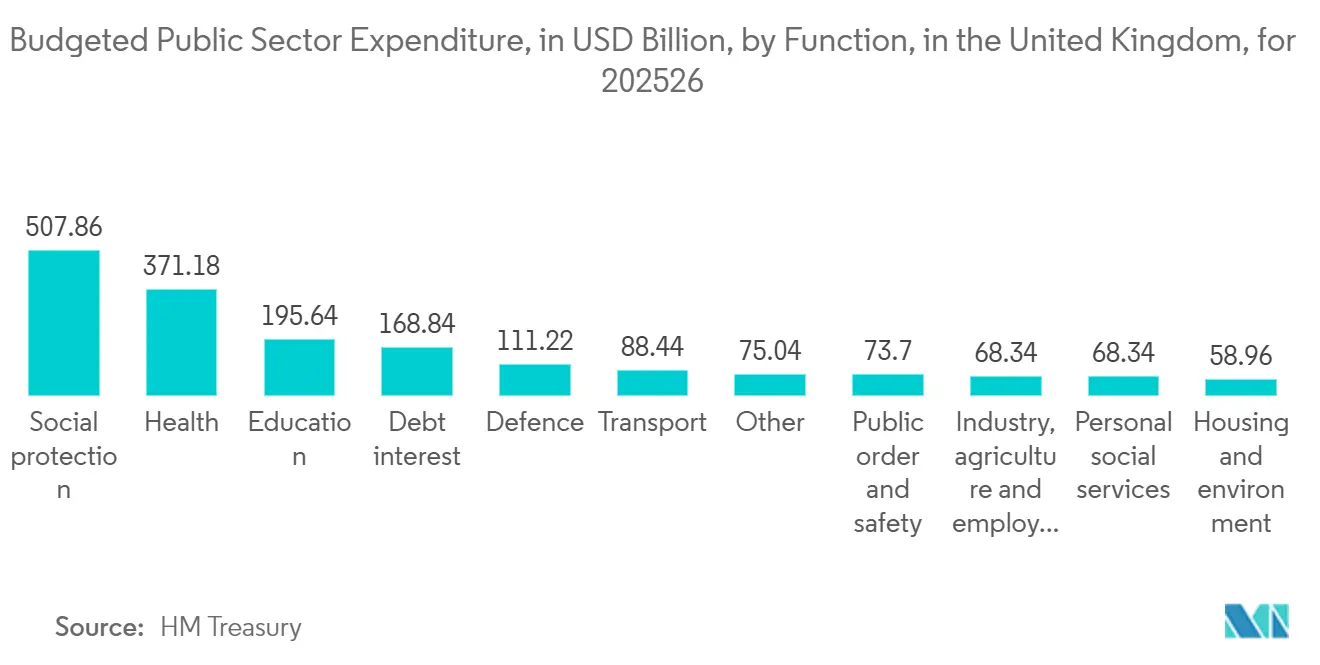
Competitive Landscape
The European surveillance IP camera market is highly competitive with several global and local players. Industry players are significantly increasing their investments in research and development to enhance innovation and solidify their market standing. Furthermore, strategic moves such as mergers, acquisitions, and partnerships are crucial in maintaining their competitive edge. Some of the key players include Bosch Security Systems GmbH, Axis Communications AB, Hanwha Vision Co., Ltd., Hangzhou Hikvision Digital Technology Co., Ltd., and Sony Corporation.
- April 2024: Sony Electronics introduced the BRC-AM7, a 4K 60p pan-tilt-zoom (PTZ) camera. This flagship model boasts a built-in lens and stands out with its PTZ Auto Framing technology, powered by artificial intelligence (AI). This technology enhances subject tracking, ensuring smoother captures. Notably, the BRC-AM7 clinches the title of the world's most compact and lightweight integrated lens PTZ camera. It stands at 225.2mm (8.87 inches) in height, 192.3mm (7.57 inches) in depth, and 168.7mm (6.64 inches) in width, weighing approximately 8.16 pounds (3.7kg).
- April 2024: Axis Communications unveiled the AXIS Q1808-LE, a bullet camera that boasts 4K image quality and exceptional light sensitivity. Equipped with a 4/3” image sensor, this camera excels in low-light conditions. Its OptimizedIR technology ensures clear footage even in complete darkness, eliminating the need for additional lighting. Further enhancing its capabilities, the camera features Lightfinder 2.0 and Forensic WDR, guaranteeing accurate colors and intricate details, even in challenging lighting conditions or near darkness. Additionally, customers can choose between a wide lens for expansive coverage or a telephoto lens for long-distance surveillance.
Europe Surveillance IP Camera Industry Leaders
-
Bosch Security Systems GmbH
-
Axis Communications AB
-
Hanwha Vision Co., Ltd.
-
Hangzhou Hikvision Digital Technology Co., Ltd.
-
Sony Corporation
- *Disclaimer: Major Players sorted in no particular order
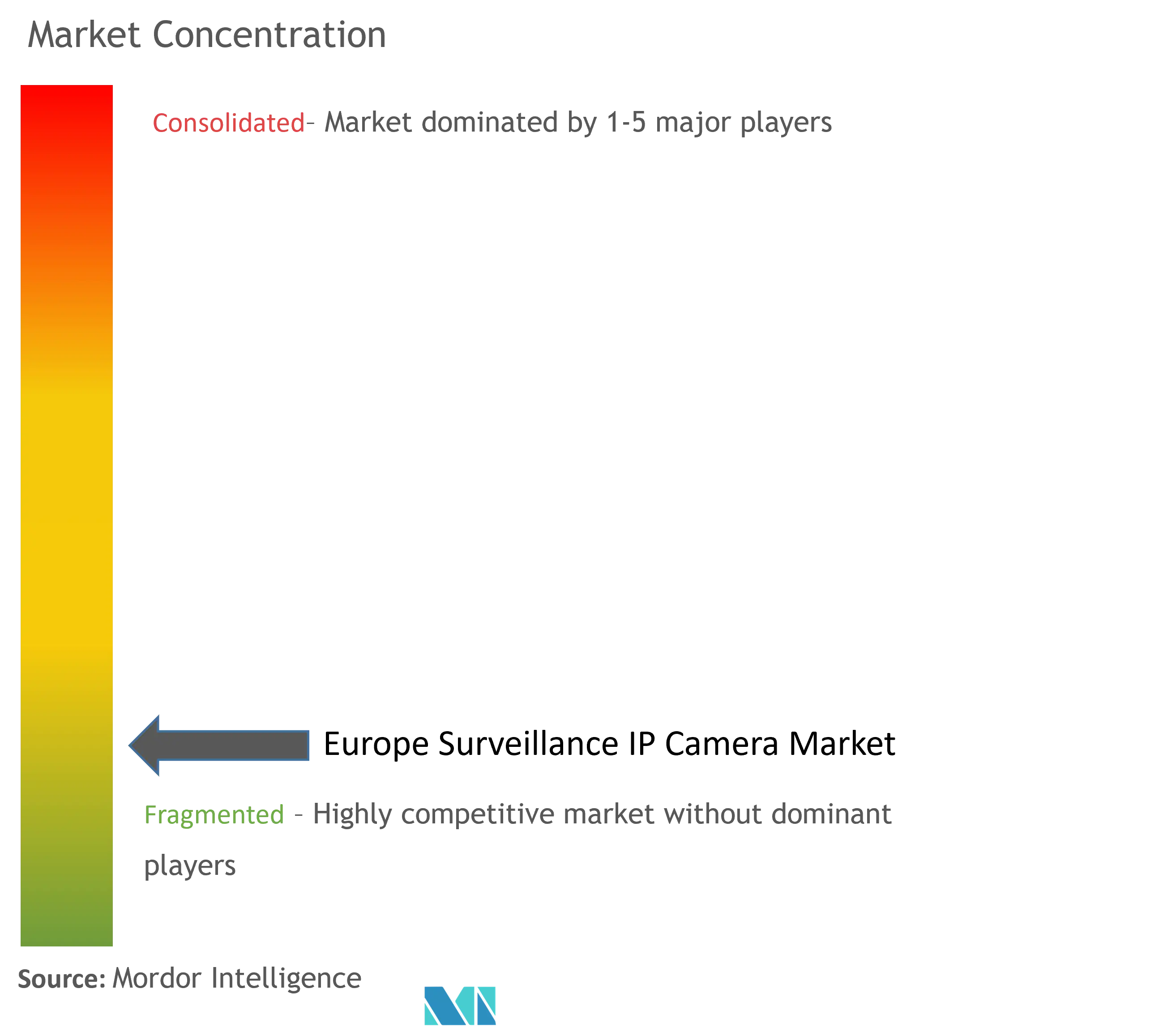
Recent Industry Developments
- April 2024: Axis Communications unveiled a versatile dome camera, integrating high-definition video, two-way audio, actionable analytics, and LED indicators. This innovative device enhances safety, security, and operational efficiency. It empowers users to streamline surveillance operations, enabling proactive resource allocation. For example, it can facilitate tele-sitting for patient monitoring in healthcare settings or aid in identifying and addressing loitering in retail spaces. The AXIS Q9307-LV Dome Camera is equipped with analytics for coughing fits and stressed voices, enhancing its capabilities for active incident management. It serves as an ideal tool for both remote monitoring and communication.
- February 2024: Vivotek is enhancing its after-sales service by extending the warranty on its network cameras and network video recorders (NVRs) to five years globally, including in the European region, aligning with the industry's highest standards. All Vivotek network cameras and NVRs of designated models, when shipped by Vivotek, will automatically come with a five-year warranty. This warranty includes robust after-sales service and technical support. Notably, Vivotek confirms that this warranty extension covers products bought through their authorized distributors.
Europe Surveillance IP Camera Market Report Scope
As an internet-based substitute for traditional closed-circuit television (CCTV) systems, IP surveillance allows IP-ready cameras to stream visual data directly to the internet. This enables camera owners to conveniently monitor feeds from their mobile devices, laptops, or any other internet-connected device, enhancing the ease of remote surveillance. Compared to CCTV, IP surveillance boasts simplified installation, higher image quality, cost-efficiency through file compression, and enhanced search capabilities. The market size is estimated by selling IP camera products across several industries. The study also tracks the market's growth trends and macroeconomic factors.
Europe surveillance IP camera market is segmented by end-user industry (government, banking, healthcare, transportation and logistics, industrial, and others [education institutions, retail, and enterprises]) and country (Germany, United Kingdom, France, and the Rest of Europe). The report offers market forecasts and size in value (USD) for all the above segments.
| Government |
| Banking |
| Healthcare |
| Transportation and Logistics |
| Industrial |
| Others (Education Institutions, Retail, and Enterprises) |
| Germany |
| United Kingdom |
| France |
| By End-User Industry | Government |
| Banking | |
| Healthcare | |
| Transportation and Logistics | |
| Industrial | |
| Others (Education Institutions, Retail, and Enterprises) | |
| By Country | Germany |
| United Kingdom | |
| France |
Key Questions Answered in the Report
How big is the Europe Surveillance IP Camera Market?
The Europe Surveillance IP Camera Market size is expected to reach USD 4.78 billion in 2025 and grow at a CAGR of 13.90% to reach USD 9.17 billion by 2030.
What is the current Europe Surveillance IP Camera Market size?
In 2025, the Europe Surveillance IP Camera Market size is expected to reach USD 4.78 billion.
Who are the key players in Europe Surveillance IP Camera Market?
Bosch Security Systems GmbH, Axis Communications AB, Hanwha Vision Co., Ltd., Hangzhou Hikvision Digital Technology Co., Ltd. and Sony Corporation are the major companies operating in the Europe Surveillance IP Camera Market.
What years does this Europe Surveillance IP Camera Market cover, and what was the market size in 2024?
In 2024, the Europe Surveillance IP Camera Market size was estimated at USD 4.12 billion. The report covers the Europe Surveillance IP Camera Market historical market size for years: 2020, 2021, 2022, 2023 and 2024. The report also forecasts the Europe Surveillance IP Camera Market size for years: 2025, 2026, 2027, 2028, 2029 and 2030.
Page last updated on:
Europe Surveillance IP Camera Market Report
Statistics for the 2025 Europe Surveillance IP Camera market share, size and revenue growth rate, created by Mordor Intelligence™ Industry Reports. Europe Surveillance IP Camera analysis includes a market forecast outlook for 2025 to 2030 and historical overview. Get a sample of this industry analysis as a free report PDF download.
